Making Issac better: How Sydney surgeons sought a window into eight-year-old’s brain
Brave eight-year-old Issac Lee has just had his third major brain surgery. This time, a specialist team at Sydney Children’s Hospital has found a less invasive, cutting-edge way to access the base of his skull to remove his tumour. Follow his incredible journey.

NSW
Don't miss out on the headlines from NSW. Followed categories will be added to My News.
Just as eight-year-old Issac Lee was about to surrender to a deep drug-induced sleep, a single tear rolled down his little cheek.
It was the heart-wrenching hint to mum Karol that her boy had been hiding his fear behind that brave face he had been wearing for weeks now.
Issac was about to undergo his third major brain surgery in eight short years of life.
Of course he was scared.
His mum was equally as frightened — not that she would show her son.
Her brave face remained intact, largely thanks to her “full faith” in the surgeons and staff at the Sydney Children’s Hospital who had become such an important part of Issac’s life.
The first two surgeries, known as craniotomies — a surgical procedure in which a part of the skull is temporarily removed to expose the brain — had shrunk Issac’s brain tumour.

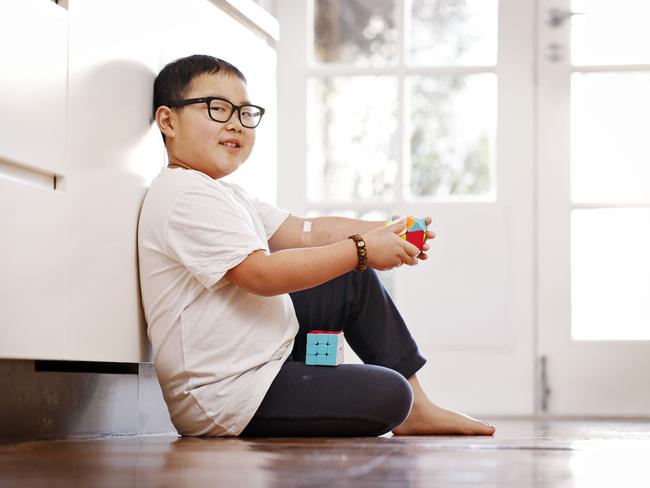
But now it was growing again, forcing its way onto vital nerves and glands and blood vessels, and making him nauseous and causing severe headaches.
This time, the specialist team from the hospital’s Base of Skull Service (BOSS) agreed on a very different, less invasive approach.
Their plan was to access the tumour that was growing at a rapid rate by entering through Issac’s nose.
The procedure is performed widely on adults, but is not so common for young children like Issac.
For Karol it was “foreign to what we knew and that made it scary”, not just for Issac but for the entire family.
“Have faith in God, he will protect you. We will be here when you wake up,” Karol said to her boy who loves breakdancing, writing songs and most of all mathematics.
The last time Issac prepared for brain surgery, around 24 months ago, he was the one calming his mum.

“Before he went in last time he was smiling, his smile was so radiant and I asked him if he was scared,” Karol recalled.
“He said: ‘No, Mummy, I’m going to sleep and when I wake up everything is going to be OK’.
“But this time he was very scared,” Karol said.
Issac was old enough this time to understand the gravity of the surgery that was ahead of him.
The patient was referred to the BOSS team by neurosurgeon Erica Jacobson, who was
also present throughout Issac’s surgery and instrumental at the time of surgery and post-operatively.
At a consultation with key team members, ear nose and throat surgeon Dr Catherine Banks and neurosurgeon Dr Jacob Fairhall, Issac listened intently.
His parents, who gave The Sunday Telegraph permission to attend, asked questions about the risks, and the details about the procedure where Dr Banks would be using a telescope and
specialised diamond drills to remove the dense bone between the large blood vessels that
supply the brain, through Issac’s nose to the tumour sitting at his skull base, giving Dr Fairhall the access he needed to remove it.
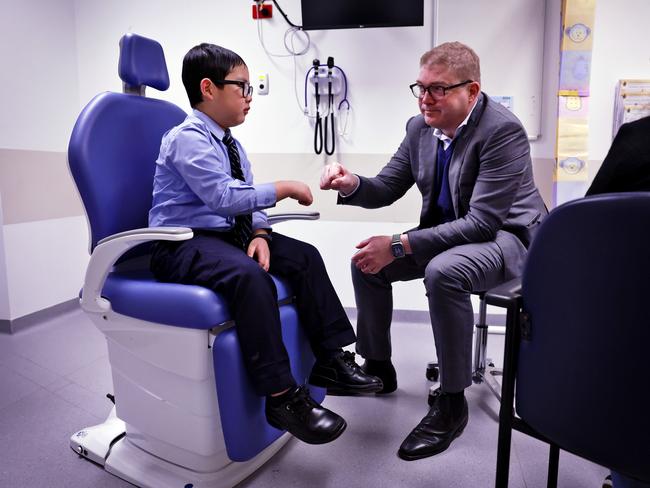
Issac was asked if he had any questions. His reply was: “No, I’m just nervous.”
The specialists allayed the fears of the Year 3 boy whose mind soon returned to maths questions he knew none of the adults in the room would have the answers for.
Then he proudly performed a portion of the latest song he had written, and looked eager to get back to his classmates at St Mary’s Catholic Primary School Erskineville.
Days later, Issac was at the hospital being prepared for the surgery that Dr Fairhall described as “high-stakes surgery in very difficult real estate”.
Issac’s tumour, which doctors discovered when he was five years old, is known as a craniopharyngioma – a rare, benign tumour at the base of the brain.
It grew in the base of his skull, the most complex area in the human body — home to the nerves that allow you to see, hear, smell, taste, talk, swallow, move and feel, and the blood vessels that supply blood to the brain.

“This tumour involves crucial parts of the brain that direct vision, hormones, movement and even body temperature and appetite,” Dr Fairhall explained.
“Issac’s brain fluid was being obstructed because of the tumour growing up into the brain’s fluid compartments causing him more headaches, nausea, making it all the more necessary for us to operate.”
In the months leading up to Issac’s surgery the BOSS team had been busy meticulously planning their approach. This team comprises over 20 dedicated experts who assist with the
decision-making and the care pathway for patients with skull base tumours.
Was there a clinical trial that would suit? Was their minimal invasive surgery the best option?
They called on Keng-Yin from the Tyree Institute of Health Engineering at UNSW to create a 3D model of Issac’s brain. Issac and his parents got to take the model home, to explore and understand exactly where the tumour was and what the doctors planned to do.
On the day of the surgery it was an excruciating wait for Karol, her husband Ricky and Issac’s big brother Jonathan.
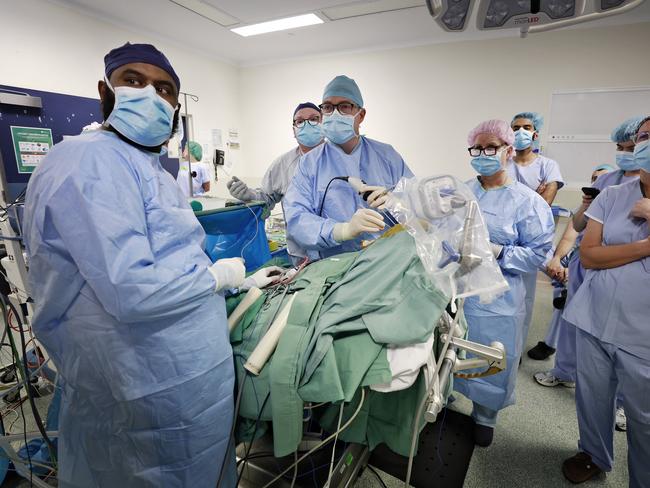
Having said goodbye around 9.30am, Karol and Jonathan fell asleep in the waiting room, only to hear after midnight their boy was being moved into recovery. Surgery had gone “fantastically well”, his doctors said.
Issac was heavily sedated, breathing through a tube for a couple of days.
However, there were no external signs of any surgical wound related to the endoscopic approach, other than a small drain from his head, which was placed at the end of the procedure.
“You would really have no idea that such an extensive surgery had been performed. It was all via the nose and done by drilling bone to create a window into the brain the size of a 5 cent piece,” Dr Banks said.
He woke to the news that the scan after his surgery was “beyond amazing”.
“Visually, to the naked eye, you couldn’t see any tumour at all,” Karol said.
“When you look at the scan it’s clean. All the doctors and nurses were so thrilled, we were thrilled, it’s an amazing result.”

Dr Banks, quick to point out the successful surgery was a team effort and unwilling to take the glory dished upon her by their colleague Dr Fairhall, said she was thrilled for Issac and his family, and the result had reaffirmed that the team’s decision-making was right.
“It’s actually amazing how well he is doing. Even after the operation I went in and saw him the very next morning and he was awake, gave me the thumbs up, even with the ventilation tube in he was so calm,” said Dr Banks who describes her job as step one and step three — making a tunnel to get to the tumour then fixing the hole once it was out.
“Then I walked past one day and he was sitting up in the ICU doing a Rubik’s cube in 36 seconds,” she said.
“I asked him how he was going and he told me he was having a ‘no technology day’, no iPad no nothing, no tech, just looking around at everyone.
“It’s truly amazing how he was functioning so quickly after surgery.”
It’s been three weeks since Issac’s operation, and apart from a small, uneventful nosebleed scare that landed him back in emergency this week, the primary school student is thriving.
The very nature of the tumour growing in Issac’s brain means he could find himself in surgery again, but for now, life is pretty close to normal — minus the breakdancing.
“He’s doing well, other than that nosebleed. He’s back to school doing half days in the afternoon, he thinks he can do more,” his mum said.
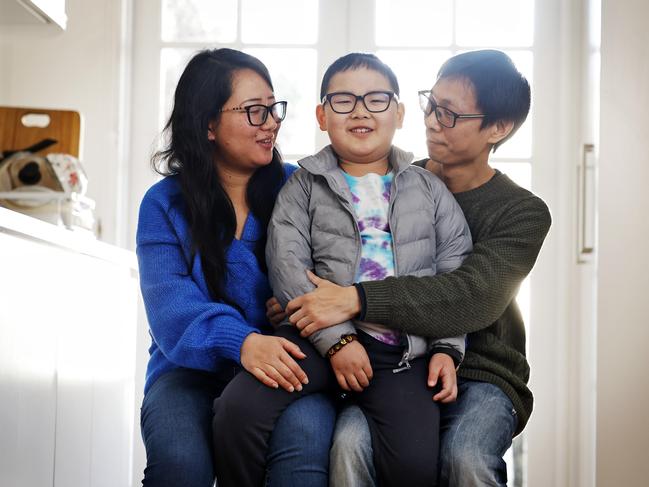
“I have to keep telling him to take it slow, it was less invasive but it was still a massive surgery.”
For Dr Banks and Dr Fairhall, Issac’s story is proof the Base of Skull Service is a vital part of the children’s hospital.
“We want to deliver the best possible care we can for the kids, make things as comfortable as possible,” Dr Banks said.
She was excited about a trial service where children like Issac who go through such complex surgeries can come back in and have internal dressings removed with much less trauma than in days gone by.
“I had to lay skin over the defect I had created so we could make a pathway to get to the tumour, so to do that I had to then pack it with dressing to hold the skin in place,” she said.
“In the past he would have to have a general anaesthetic to have that removed or be awake and that would be extremely uncomfortable. But now we have him come in, have a sedation, remove the dressings, clean it out and he can go back to school the same day,” she said.
“It’s a little bit of a pilot study but patients love it, parents love it so we are hoping to extend that trial program.”
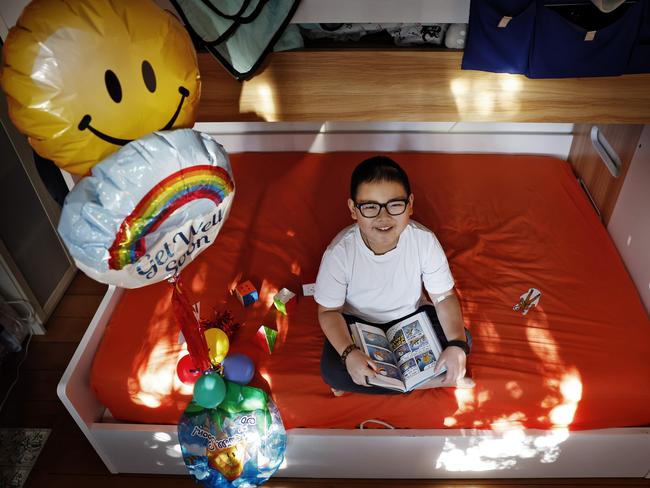
The service for all kids who have base of skull conditions, that often mean repeated surgeries, anaesthetics and long stints in hospital, is functioning thanks to the support of the Sydney Children’s Hospital Foundation.
Spokeswoman Yvonne Stewart said generous donors were helping “fast-track transformative care through programs such as the Base of Skull Service, an Australian first in pediatrics.”
The foundation is contributing more than $2 million across three years to provide access to “sophisticated imaging technology and to support the BOSS team in providing ongoing training in minimally-invasive surgical techniques that reduce scarring and shorten recovery times,” Ms Stewart said.
“Philanthropy will also help the BOSS team to provide personalised coordinated care for these complex patients throughout their hospital journey. This pioneering approach is a game-changer.”
Issac and his family will be forever grateful.
The very nature of Issac’s tumour means he could be back again, but he knows the team have his best interests at heart. And they will miss his jokes and his break dancing.
Do you have a story for The Daily Telegraph? Message 0481 056 618 or email tips@dailytelegraph.com.au





